What would you say is the worst polluting industry in the world today? You may think about transportation, manufacturing, or agriculture. Very few would think that fashion is the second worst polluting industry behind the oil and gas industry. Slow & Sustainable fashion is saving the world one t-shirt at a time.
How can the fashion industry be so environmentally toxic? Well, when you look at what is required in the production of garments, the reality begins to set in. The most popular fabric used today, polyester, is made from byproducts of fossil fuels. The second most used fabric is generic cotton, which is heavily sprayed with fertilizers, herbicides, and pesticides. In addition to the huge amount of water used in the manufacturing of all garments, the fashion industry poisons the earth up until the death of the garment. Landfills add millions of pounds of textiles every year, and water is constantly being flushed with billions of parts of microplastics too small for the filters to catch, and too toxic from the dyes and chemicals being used.
Sustainable and slow fashion aims to fix these problems by addressing some of the major concerns. Companies are saving the world one step at a time, here’s how…
1. Saving the World with Water
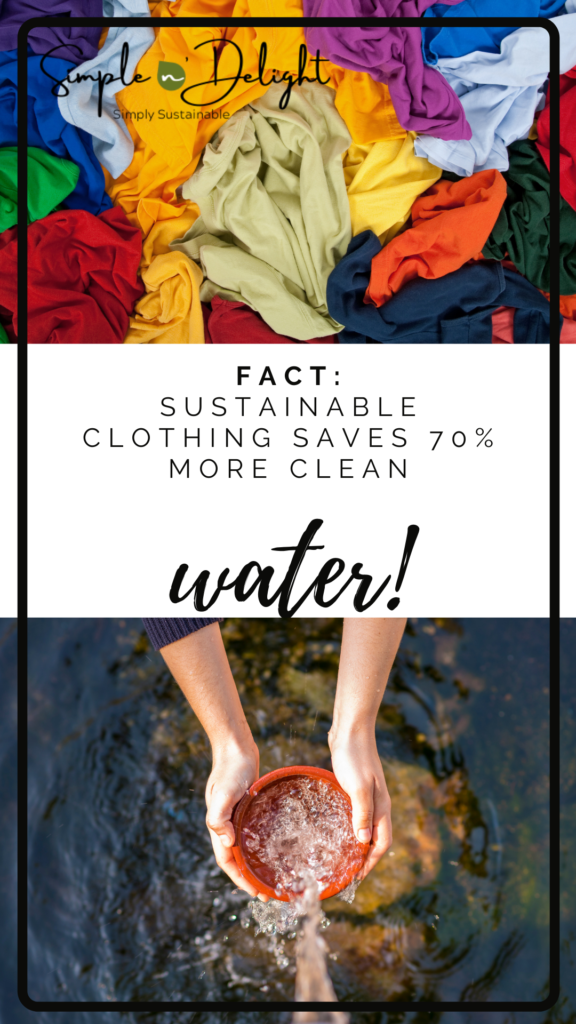
We are the blue planet, but only 3% of the world’s water is usable. One out of ten of us struggles to find clean drinking water. This problem is only getting worse as our population grows, and the world temperature continues to augment.
The mainstream fashion industry uses a huge amount of water in the production of textiles. Quantities of water depend on the country of manufacture, local regulations, and the material being produced. When studied against cotton and viscose, “…data indicate that on average polyester has the highest water footprint.”[1]
Many of us have heard the shocking statistic of mainstream cotton, how 20 000L of water is used in the production of one T-shirt and a pair of jeans! Sustainable fabrics such as Organic Cotton, Tencel, Hemp, and Linen require much less water per Kg of fabric produced.
Sustainable fashion utilizes less water in the production of textiles.
Global Average Water Footprint (L) to Produce 1Kg of Textile
| Fabric Being Used | Liters Used per 1Kg of Fabric Made |
| Non-Organic Cotton[2] | 10 000L |
| Organic Cotton [2] | 3 000L |
| Linen[3] | 3 500L |
| Tencel [4] | 4 200L |
| Hemp[5] | 2 179L |
2. Saving the world by Paying a Living Wage
Most fashions are manufactured in places where regulatory wages are not even considered. China, Cambodia, Vietnam, India, and Bangladesh are all among the countries that famously churn out millions of garments every year due to the low cost of labor. Unfortunately, the people working in these factories are largely women and rarely make enough to pay for the basic living costs for their families. Working conditions are also unregulated and oftentimes unsafe. Children end up working in factories as well. Less than 1% of the cost of a T-Shirt ends up in the pocket of the person who stitched it together.
Sustain fashion aims to pay workers a fair salary and meet health and safety requirements for workers. When supporting sustainable fashion we need to remember that we are all connected in this world, and we make the world a better place when we support each other. When workers thrive, we do too.
3. Saving the World by Reducing Landfills
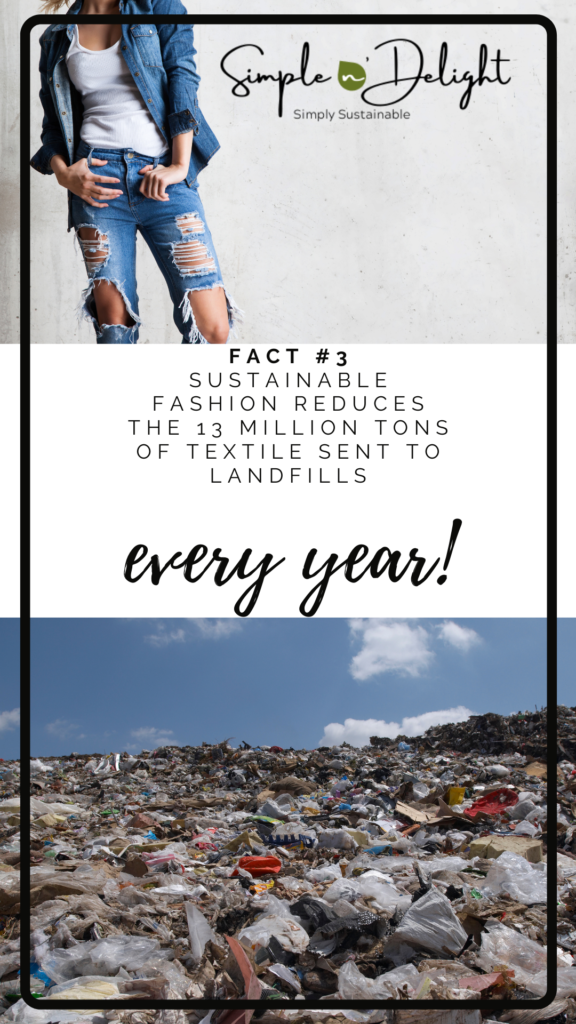
Globally we add 13 million tons of textiles to landfills every year. Many of those fabrics do not decompose easily. For example, polyester can take up to 200 years to decompose. Even cotton, a simple natural fiber that usually takes less than a year to decompose under normal oxygenated conditions, can sit in landfills for much longer due to the lack of oxygen from too much piling of garbage. In Toronto, Canada, the Ontario Science Center has a great display of the effects of thousands of pounds of garbage piling in landfills demonstrating how the lack of oxygen can preserve even the most biodegradable objects.
As the population grows, landfills only get larger, and space on the earth becomes more and more limited. Sustainable fashion reduces waste in our landfills on a few fronts.
Garments are utilized for longer periods due to better quality.
Garments are often able to be recycled into new textiles.
Garments are often donated and passed onto the next user and sold.
Garments are made of natural materials that require less waste in production.
Garments are often made of sustainable fabric that can easily decompose.
4. Saving the World by Utilizing Fewer Chemicals and Pesticides

Millions of tons of pesticides, insecticides, and fertilizers are used annually in the productions of most of the textiles we employ today. These chemicals do not easily go away. They get stuck in our water, our food, our animals, and even in our bodies. According to the World Bank, 20% of all water pollution comes from the textile industry. The toxicity of these chemicals contributes to environmental and health problems.
Switching to sustainable fabrics such as hemp and organic cotton limits exposure to these chemicals. Slow fashion brands are often verified by a third party to ensure they are meeting environmental standards. Global Organic Textile Standard (GOTS), Oeko-Tex® Standard 100, bluesign®, or the EU Ecolabel are amongst some of the third parties working towards a healthier textile industry and a more sustainable world.
5. Saving the World by Reducing Microplastics
If you want to read more about how microplastics are becoming so pervasive in our waters and food supply, click here to read the article “11 Rules for Addressing the Modern Microplastic Mess”.
In short, textiles are the number one contributor to microplastics getting into our water, fish, and bodies. Our clothing is often made from plastics and environmentally unfriendly materials such as lycra, spandex, fleece, and polyester. Over time, during the wash cycle, clothing sheds microparticles of plastic into the water too small for regular filtration to pick up. In turn, these particles end up where they don’t belong.
Sustainable fashion aims to solve that problem by utilizing fabrics that are naturally sourced and can easily be returned to the earth and ecosystem. Fabrics today are being created by many different plants. Hemp, pineapple, flax, eucalyptus, wood pulp, organic cotton, jute, and wool are some of the most sustainable materials used to develop new fabrics which can sustain washes and do not leech microplastics into the wash cycle.
If you think that this is not a serious concern, just think about the fact that as humans we ingest up to a credit card worth of plastics EVERY WEEK from the food we eat and the water we drink. [6]
6. Saving the World by Growing Sustainable Crops
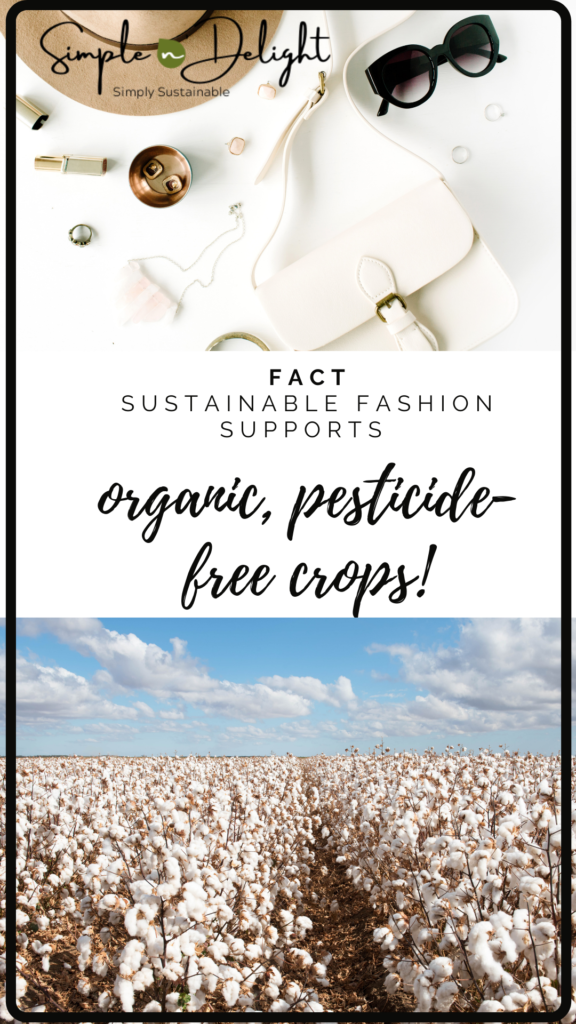
Sustainable crop production finds ecological ways to focus on soil health and biodiversity instead of chemical fertilizers and pesticides. Growing sustainably means we take into consideration the animals which feed off of the land and in turn naturally fertilize the soil. With less chemical fertilizers and pesticides use, the land is not depleted and can easily regrow crops utilizing less water and new space for the production of materials. Deforestation happens less since land is quickly reusable to plant new crops.
7. Saving the World by Reducing the Need for Fossil Fuels
Polyester is the number one fabric being produced and used in the world today. Polyester, acrylic, nylon, and spandex are among some of the textiles being produced from synthetic polymers made from fossil fuels. In Bill Gates’ book, “How to Avoid a Climate Disaster”, he discloses the necessity of getting to zero emissions by 2050. Utilizing fewer fossil fuels is one of the ways that we stand a chance to reach zero emissions. Fossil fuels not only add to more carbon in our atmosphere, but they are also non-renewable resources and should be used only when no other option exists.
Producing textiles without the reliance on fossil fuels is a step in the right direction and sustainable slow fashion does just that.
8. Saving the World by Changing our Mentality
There was a time when quantity meant more than quality for me; when I would go to the mall as a pass-time rather than a necessity. Slow fashion has changed my mentality to want less, need less, and be more with less.
Sustainable fashion allows us to focus on curating the perfect wardrobe for one’s style. The capsule wardrobe illustrates this perfectly: needing only a few perfect pieces of clothing that can mix and match well with anything else.
This mentality extends into other aspects of life as well: trying to reduce waste, choosing the quality of quantity, and caring well for our things. It induces respect for the people and things around us and brings us to a higher level of consciousness where we are all connected in this world we live in.
To read more about reducing waste take a look at the Zero Waste Challenge.
When we stop to think about how our fast fashion garments are made in Cambodia, where the woman who sewed shirts returns home after a 10 hour day to try to feed her family and sleep on a dirt floor, we begin to feel the need for change. Sustainable fashion allows the western world to feel grateful while at the same time humble and gracious.
9. Saving the World by Empowering Women
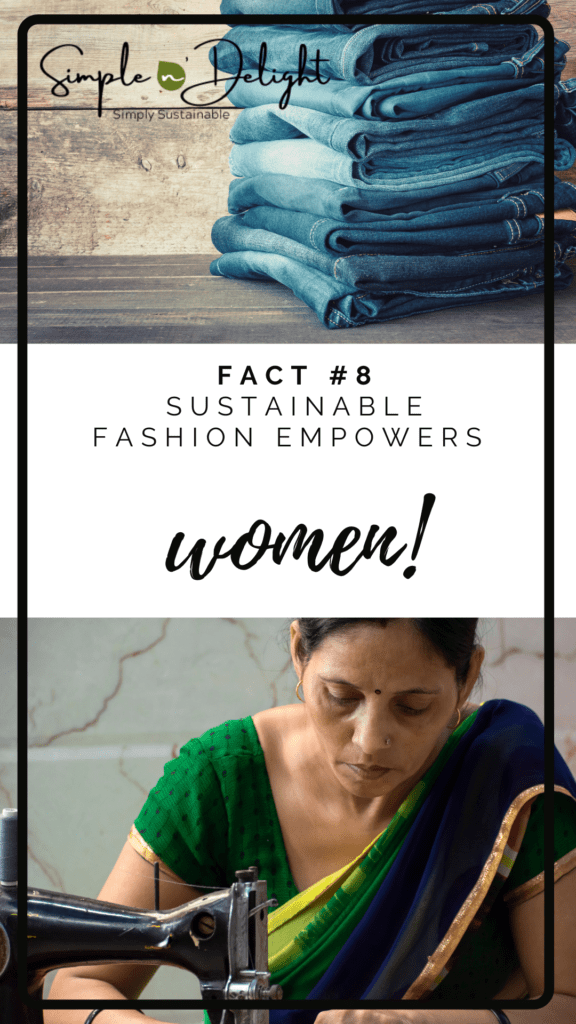
Women account for about 50% of the total population but make up 80% of the garment industry labor. Eighty-five percent of the fashion labor force do not make a living wage. Fast fashion is a woman’s issue. Poverty is the driving force behind maintaining most of the fashion brands we know of today. Women are too poor to deny the low wages and inhumane work conditions, that they keep working for as little as 2¢ per garment sewn.
Sustainable and slow fashion companies seek to change this story. Some of the more female progressive brands today in the fashion world today are Eileen Fisher, Patagonia, Pact, Able, and Girlfriend Collective. These companies focus on fair labor practices, sustainable materials, and lower waste outputs.
10. Saving the World by Limiting our Dependence on Animals
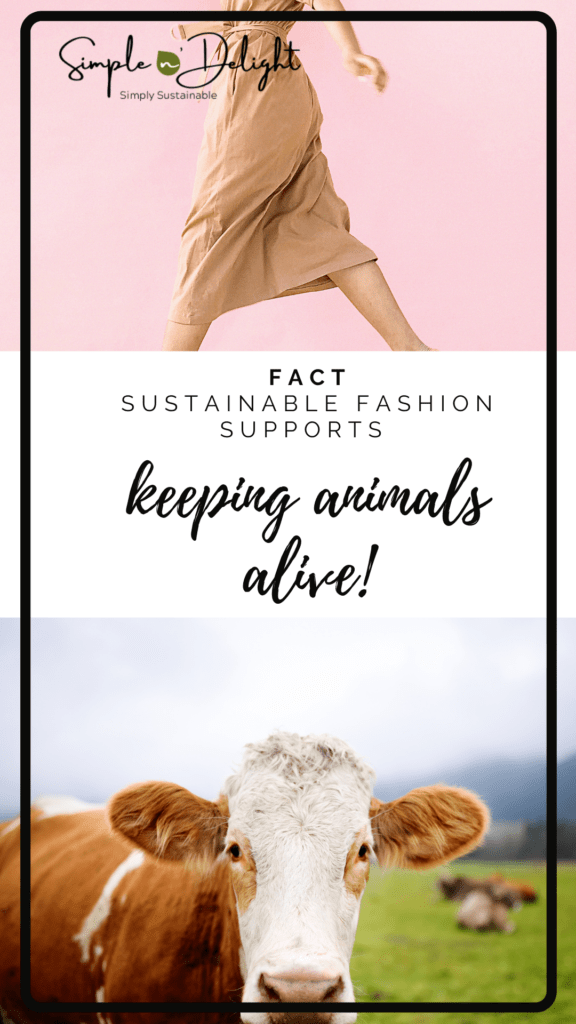
A large portion of the fashion industry still utilizes animals as a primary source of materials. Leather, fur, feathers, wool, and silk are all animal-derived and used to make garments and shoes. Besides the huge detriment of killing animals for their raw materials, farming animals for fashion is not environmentally sustainable. The land, the greenhouse gases, and the chemical waste used in production are a liability to the earth.
The textiles used in the production of sustainable and slow fashion garments do not use animals as their sources of materials. Fabrics are grown using sustainable practices and materials that are eco-friendly. If we are trying to come full-circle in our quest for environmental freedom, we need to divorce companies that use animals for their production.
What’s next?
Sustainable and slow fashion will only work if we support the businesses behind these initiatives. For more on how to slowly become more sustainably fashion-conscious, take a look at the following article:
References








5 Responses
These are great ways that I did not recognize were so impactful on the environment. Thanks for enlightening me how sustainable fashion is making a difference.
Its 2022 its time we continue to be aware and do our part protecting our planet. Ive been trying to be more sustainable and avoids fast fashion
This was so informative. I knew of many but in detail. Some things I would not have considered such as empowering women. Also, I am all for limiting our dependence on animals.
Nice post 🙂
It’s the time for a lot of people to be much more aware and involve in saving our land. ☺️✨ Thanks for sharing